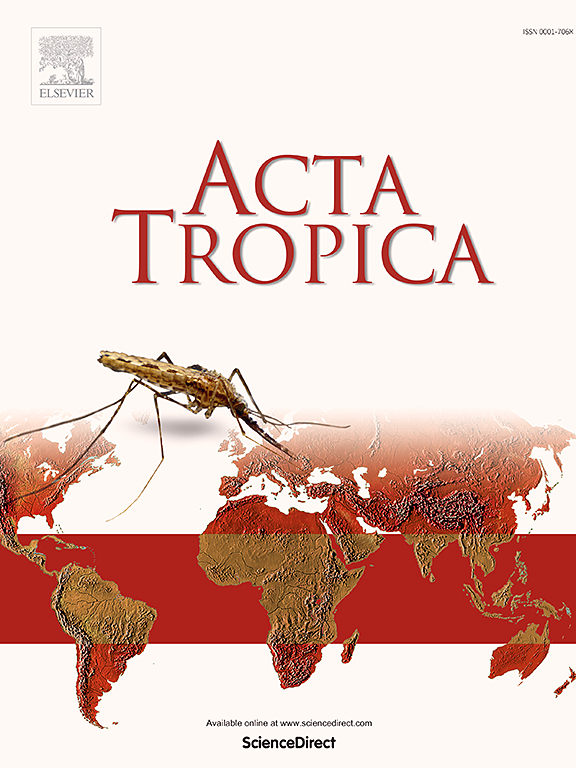使用感染后30天的小鼠模型,UVB辐射损害CD4+和IFNγ+细胞反应,促进IL-10+细胞并加剧墨西哥利什曼原虫引起的病变
IF 2.1
3区 医学
Q2 PARASITOLOGY
引用次数: 0
摘要
在小鼠中,对利什曼原虫感染的易感性或耐药性与不同的CD4+ t辅助细胞反应有关。以慢性疾病为特征的主要Th2反应与促进愈合和寄生虫清除的Th1反应形成对比。紫外线B (UVB)辐射通过损害抗原呈递细胞功能,刺激IL-10的产生,并使Th1/Th2平衡向由IL-4和IL-10主导的Th2表型倾斜,从而诱导局部和全身免疫抑制。本研究研究了感染墨西哥利什曼原虫的uvb免疫抑制C57BL/6小鼠的疾病进展和早期局部免疫反应。小鼠暴露于免疫抑制剂量的UVB辐射,随后感染墨西哥乳杆菌。评估病变大小、寄生虫载量、组织病理学以及病变部位IL-10+、IFN-γ+、肥大细胞、巨噬细胞(MOMA2+)、CD4+和CD8+ T细胞的存在。与野生型墨西哥乳杆菌感染对照相比,暴露于uvb的墨西哥乳杆菌感染小鼠表现出组织结构改变,完整肥大细胞和脱颗粒肥大细胞数量增加,皮肤病变处IL-10+和MOMA2+细胞浸润升高。相反,uvb暴露组CD4+、CD8+和IFN-γ+细胞减少。这些发现表明,暴露于UVB辐射是皮肤利什曼病(LCL)的一个危险因素,因为这些发现表明,它可以通过诱导不利的免疫微环境加重病变并增加寄生虫负荷。本文章由计算机程序翻译,如有差异,请以英文原文为准。

UVB radiation impairs CD4+ and IFNγ+ cell responses, promoting IL-10+ cells and exacerbating lesions caused by Leishmania mexicana using a mouse model 30 days post-infection
In mice, susceptibility or resistance to Leishmania spp. infection is associated with distinct CD4+ T-helper cell responses. A predominant Th2 response, characterized by chronic disease, contrasts with a Th1 response, which promotes healing and parasite clearance. Ultraviolet B (UVB) radiation induces local and systemic immunosuppression by impairing antigen-presenting cell function, stimulating IL-10 production, and skewing the Th1/Th2 balance towards a Th2 phenotype dominated by IL-4 and IL-10. This study investigated disease progression and early local immune responses in UVB-immunosuppressed C57BL/6 mice infected with Leishmania mexicana. Mice were exposed to immunosuppressive doses of UVB radiation and subsequently infected with L. mexicana promastigotes. Lesion size, parasite load, histopathology, and the presence of IL-10+, IFN-γ+, mast cells, macrophages (MOMA2+), CD4+, and CD8+ T cells at the lesion site were evaluated. UVB-exposed, L. mexicana-infected mice exhibited altered tissue architecture, increased numbers of both intact and degranulated mast cells, and elevated IL-10+ and MOMA2+ cell infiltration in skin lesions, compared to wild-type, L. mexicana-infected controls. Conversely, CD4+, CD8+, and IFN-γ+ cells were decreased in the UVB-exposed group. These findings suggest that exposure to UVB radiation acts as a risk factor for cutaneous leishmaniasis (LCL), as these findings indicate it can exacerbate lesions and increase parasite load through the induction of an unfavorable immune microenvironment.
求助全文
通过发布文献求助,成功后即可免费获取论文全文。
去求助
来源期刊

Acta tropica
医学-寄生虫学
CiteScore
5.40
自引率
11.10%
发文量
383
审稿时长
37 days
期刊介绍:
Acta Tropica, is an international journal on infectious diseases that covers public health sciences and biomedical research with particular emphasis on topics relevant to human and animal health in the tropics and the subtropics.
 求助内容:
求助内容: 应助结果提醒方式:
应助结果提醒方式:


